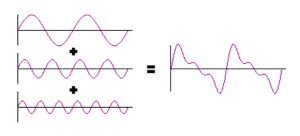This demonstration requires the spectrum analyzer and a microphone. It can be performed with different musical instruments and human voices.
Materials:
- Spectrum analyzer
- Xylophone
- Guitar
- Harmonica
Demo:
The same musical note C is played on a xylophone, guitar, and harmonica. The fundamental frequency is the same for all of the instruments, but the tone color (timbre) is different due to various harmonics. Each instrument produces a different combination of harmonics to create the same “B flat” note, for example. This is why an instrument like the clarinet does not sound like an oboe, even when they are playing the same note. Harmonic contents for each of the musical instruments are shown below.
These harmonic spectrums are a breakdown of the harmonic frequencies that compose each sound as a whole. The harmonic spectrum of the guitar (figure 2) shows several intense high frequency harmonics on the left, and a few low frequency harmonics with a much smaller intensity on the right.
Explanation:
Harmonics are a family of frequencies which are integer multiples of a common fundamental frequency. As a result of their unique physical structure and the nature of their operation, different musical instruments produce different combinations of harmonics when playing the same notes. Each of these harmonics blend to create the desired notes (Figure 5).

Figure 5: Image from, howmusicworks.org.
The images above show how the harmonic spectrum of a xylophone (Figure 1) is concentrated in a couple areas; as it produces consistent notes from the blow of a mallet upon a precise plank of rigid material. This is sharply contrasted by the wide range of harmonics produced by the harmonica (Figure 3), which uses the breath of its player, and a sensitive metal reed to produce a single note. The greater number of factors involved in playing the harmonica, as opposed to the xylophone, is responsible for its greater number of independent harmonic frequencies. The timbre, or characteristic sound of an instrument, comes from this harmonic range.
Written by: Alek Beck


